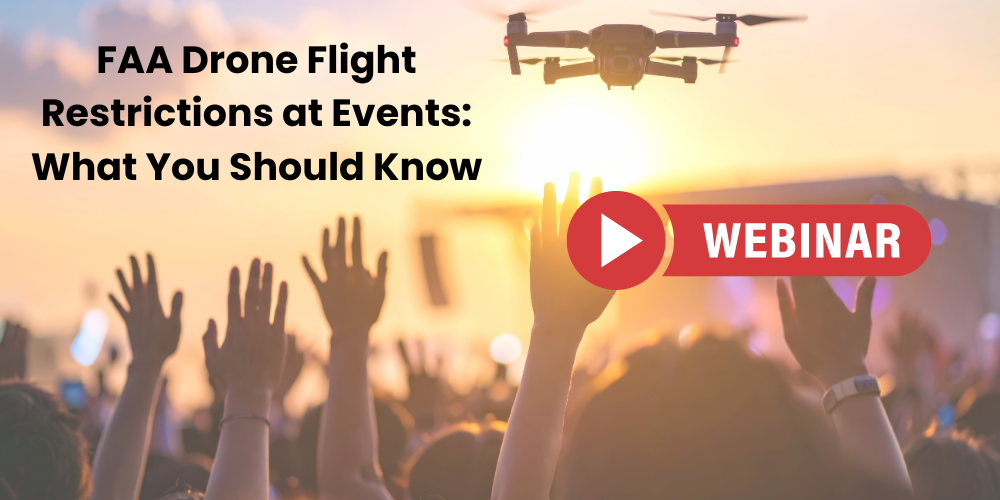Summary: The Federal Aviation Administration issues temporary flight restrictions (TFRs) — including for drones — to block or control airspace for a defined time and area, typically around major events, emergencies, or sensitive sites.
For event managers and security teams, monitoring drone TFRs is vital to maintain compliance and avoid costly violations. FAA’s new drone TFR rules give law enforcement power to restrict drones at stadiums and large events, boosting airspace safety and crowd security.
The Federal Aviation Administration (FAA) has released a major update to its drone TFR (Temporary Flight Restriction) policy, introducing new capabilities for law enforcement to restrict drone operations at large public gatherings, stadiums, and major events. This update, outlined in Notice JO 7210.960, is effective as of August 7, 2025, and reflects growing concerns over unauthorized drone flights in crowded environments.
Unlike traditional TFRs that applied to all aircraft, this new temporary flight restriction for drones under Section 44812 is focused solely on unmanned aircraft systems (UAS) — a shift designed to better align with modern airspace security needs.
Why the FAA Drone TFR Update Matters
The FAA’s new drone flight restrictions for stadiums and events aim to enhance public safety by giving law enforcement greater control over airspace during high-attendance outdoor events.
From concerts to major sporting events, drones endanger crowds, create security vulnerabilities, and disrupt law enforcement operations.
What’s New: Key Highlights of the FAA Drone TFR Policy
The FAA now allows drone-only TFRs under a statutory authority granted by the FAA Reauthorization Act of 2024. These restrictions apply exclusively to unmanned aircraft operations and can be requested by law enforcement under two event categories:
Stadium/Venue Category (44812(c)(1)):
- Must be in a stadium/venue that previously hosted events requiring special security instructions under Public Law 108-199 (e.g., NFL games, major concerts)
- Venue must not be enclosed
- Minimum 30,000 estimated attendance
- Must be publicly advertised
Other Large Gathering Category (44812(c)(2)):
- Minimum 100,000 estimated attendance
- Primarily outdoors
- Defined and static geographical boundary
- Must be publicly advertised
These new FAA drone restrictions differ from past policies by offering targeted protections for events where drones present a unique threat.
TFR Drone Approval and Enforcement Details
Who Can Request a Drone TFR?
Only credentialed law enforcement agencies — Federal, State, local, Tribal, or territorial — are eligible to request a TFR for drones at events. The request must be submitted at least 30 days prior to the event.
Where to Submit Your Request
Requests go through the appropriate FAA Air Traffic Organization (ATO) Service Center based on your event location. You can use the FAA’s UAS UDDS interactive map to determine your regional center.
Submission Emails:
- Eastern Region: 9-ATO-ESA-TFR-44812@faa.gov
- Central Region: 9-ATO-CSA-TFR-44812@faa.gov
- Western Region: 9-ATO-WSA-TFR-44812@faa.gov
Include in your request:
- Event name, date, and time
- Address and GPS coordinates
- Desired altitude and airspace radius
- Contact details
When Drone Flights Are Still Allowed
Even within a drone TFR, unmanned aircraft operations may still be authorized if:
- The FAA Administrator determines the flight is necessary for safety, security, or compliance, OR
- The requesting law enforcement agency approves the operation
What The New TFR Means for Law Enforcement and Stadium Security Teams
This TFR represents a significant evolution in TFR policy, creating the first statutory authority specifically designed to address unmanned aircraft operations at large public events, driven by the FAA Reauthorization Act of 2024.
Whether you’re managing a stadium, securing a major outdoor event, or part of a public safety team, this rule gives you a powerful new tool to keep your airspace safe:
-
More Control Over Event Airspace
You can now request a federally backed drone restriction zone, keeping drones out of your skies. Despite the legal boundaries, there will still be pilots-whether careless or unaware, who fly anyway. That’s why it’s critical not to over-rely on policy alone. While the TFR gives you the authority to act, a drone detection system gives you the awareness to respond.
-
Stronger Legal Backing
The TFR provides clear FAA authority to act against unauthorized drone activity during large-scale gatherings.
-
Greater Planning Responsibility
TFRs must be requested at least 30 days in advance, so coordination between law enforcement, event planners, and the FAA is more important than ever.
Temporary Flight Restriction (TFR) FAQs
What exactly is a Temporary Flight Restriction (TFR)?
A TFR is a regulatory order by the Federal Aviation Administration (FAA) that forbids or restricts aircraft — often including drones — from entering a specified airspace for a set duration, usually for events, emergencies, disasters, or other high-risk operations.
Why are TFRs important for drone risk management at large events or stadiums?
At concerts, sports games, large gatherings or sensitive facilities, drones pose risks of intrusion, surveillance, payload delivery or interference. A TFR creates a clear “no-fly” zone, making alerting and enforcement easier, and enhancing safety for both the event and nearby air traffic.
Who decides when and where a TFR is applied?
The FAA issues TFRs, often in coordination with local or state authorities, event organizers or security agencies. They determine the location, altitude, duration, and which aircraft (including drones) are subject to restriction.
How does a TFR affect drone operations?
Drone operators must avoid or obtain special authorization/waiver to fly within a TFR zone during its active period. Failure to comply can lead to enforcement action by the FAA, local law enforcement or other authorities.
What should event security/planning teams know when a TFR is in place?
- Ensure your air-space security plan integrates the TFR notice: know start/end times, area, altitudes.
- Notify stakeholders (drones used by media, relay systems, VIP helicopters) to check for compliance.
- Coordinate with your drone-detection systems (e.g., RF, radar, EO/IR) so you know when a drone enters restricted airspace.
- Develop protocols for identifying, alerting, and responding to unauthorized drones during a TFR event.
What are the limitations of TFRs for drone mitigation?
- A TFR only restricts legal flights; rogue or uncompliant drone operators may ignore or not know about it.
- Enforcement depends on detection and response capability — a TFR by itself doesn’t detect or stop a physical drone threat.
- Airspace restrictions may not cover low-altitude drones or small craft if not explicitly included in the TFR.
How should organizations integrate TFR awareness into their drone-detection and security programs?
- Include TFR status and coverage in your threat assessment (know if a TFR applies for your event/site).
- Configure your detection system to raise alerts if drones cross into a TFR-protected zone.
- Train staff on the legal/regulatory meaning of the TFR, so they understand the significance of detecting a drone violation during the restricted period.
- After the event, review any intrusion or near-miss incidents and integrate lessons learned for future TFR-protected events.

